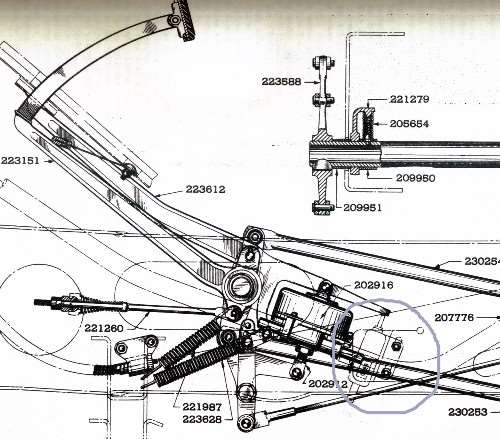Re: Easamatic Rebuild Sources
Posted by Owen_Dyneto On 2013/10/5 22:34:57
No similarity whatsoever between the earlier units and the BTV except that they both utilized vacuum to provide the motive force. The earlier (thru 1936) B-K systems used on the mechanical brake seniors used a vacuum cylinder attached to the frame somewhat below the rear floorboards with a cable attachment to the mechanical linkage at the pedal shaft which was actuated by a valving arrangement intergrated into the brake pedal linkage. When the seniors went to hydraulic brakes it was still a simple vacuum cylinder but linked directly by it's cylinder shaft (no cable) to the brake pedal linkage. So no, the BTV was not an evolution of the earlier designs in any stretch of the word' these early hydraulic systems used an entirely conventional master cylinder with the pull of a remote vacuum cylinder applied to the pedal linkage. If you examine the image from the 33-36 parts book of the brake pedal and linkage, you'll see the actuating valve and at the very bottom of the picture is the cable going rearward to the booster can. The feature that's circled (from a prior inquiry) is the brake light switch.
I don't believe Packard offered any kind of power brake system between 1941 and 1951; not entirely sure about 1940 but I believe the last prewar Packard with power brakes was the 1939 Twelve.
And no, the 1951 Packard was not the first car to use the BTV, it was first offered in 1952 with a retro kit available for installation on 1951 Packards. As far as first useage of the BTV, I believe Packard was first in 1952 with the slide valve (type 3A) model; in 1953 it was offered by Olds, Lincoln, & Mercury, followed by Chevrolet, Hudson, Nash and Pontiac in 1954, and then with the poppet valve style by Cadillac, Lincoln Continental, Rambler, Buick, Edsel and finally in the early 60s by Mercedes-Benz.
The other power brake system used in the 20s and 30s by several European makes and in the US only by Pierce-Arrow was a very unusual design adopted in the US by Stewart Warner which used the rotation of the driveshaft via a multiple disc pack arrangement somewhat like and old bicycle coaster brake to provide the boost effort. I may have a description of it somewhere. The neat thing about was that the faster the car went, the more the boost. I forget where the original design originated in Europe, perhaps with Daimler or maybe Hispano. CORRECTION - the system was powered by a transmission output shaft, not the driveshaft and I'm told it was used by Roll-Royce thru the mid-60s.
Attach file:
 (37.72 KB)
(37.72 KB)

 (159.76 KB)
(159.76 KB)

I don't believe Packard offered any kind of power brake system between 1941 and 1951; not entirely sure about 1940 but I believe the last prewar Packard with power brakes was the 1939 Twelve.
And no, the 1951 Packard was not the first car to use the BTV, it was first offered in 1952 with a retro kit available for installation on 1951 Packards. As far as first useage of the BTV, I believe Packard was first in 1952 with the slide valve (type 3A) model; in 1953 it was offered by Olds, Lincoln, & Mercury, followed by Chevrolet, Hudson, Nash and Pontiac in 1954, and then with the poppet valve style by Cadillac, Lincoln Continental, Rambler, Buick, Edsel and finally in the early 60s by Mercedes-Benz.
The other power brake system used in the 20s and 30s by several European makes and in the US only by Pierce-Arrow was a very unusual design adopted in the US by Stewart Warner which used the rotation of the driveshaft via a multiple disc pack arrangement somewhat like and old bicycle coaster brake to provide the boost effort. I may have a description of it somewhere. The neat thing about was that the faster the car went, the more the boost. I forget where the original design originated in Europe, perhaps with Daimler or maybe Hispano. CORRECTION - the system was powered by a transmission output shaft, not the driveshaft and I'm told it was used by Roll-Royce thru the mid-60s.
Attach file:
 (37.72 KB)
(37.72 KB)
 (159.76 KB)
(159.76 KB)
This Post was from: https://packardinfo.com/xoops/html/modules/newbb/viewtopic.php?post_id=132574